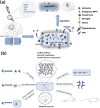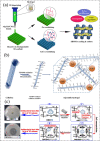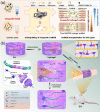Recent advance in bioactive hydrogels for repairing spinal cord injury: material design, biofunctional regulation, and applications
- PMID: 37488557
- PMCID: PMC10364437
- DOI: 10.1186/s12951-023-01996-y
Recent advance in bioactive hydrogels for repairing spinal cord injury: material design, biofunctional regulation, and applications
Abstract
Functional hydrogels show potential application in repairing spinal cord injury (SCI) due to their unique chemical, physical, and biological properties and functions. In this comprehensive review, we present recent advance in the material design, functional regulation, and SCI repair applications of bioactive hydrogels. Different from previously released reviews on hydrogels and three-dimensional scaffolds for the SCI repair, this work focuses on the strategies for material design and biologically functional regulation of hydrogels, specifically aiming to show how these significant efforts can promoting the repairing performance of SCI. We demonstrate various methods and techniques for the fabrication of bioactive hydrogels with the biological components such as DNA, proteins, peptides, biomass polysaccharides, and biopolymers to obtain unique biological properties of hydrogels, including the cell biocompatibility, self-healing, anti-bacterial activity, injectability, bio-adhesion, bio-degradation, and other multi-functions for repairing SCI. The functional regulation of bioactive hydrogels with drugs/growth factors, polymers, nanoparticles, one-dimensional materials, and two-dimensional materials for highly effective treating SCI are introduced and discussed in detail. This work shows new viewpoints and ideas on the design and synthesis of bioactive hydrogels with the state-of-the-art knowledges of materials science and nanotechnology, and will bridge the connection of materials science and biomedicine, and further inspire clinical potential of bioactive hydrogels in biomedical fields.
Keywords: Bioactivity; Biomedical engineering; Functional regulation; Hydrogels; Spinal cord injury.
© 2023. The Author(s).
Conflict of interest statement
The authors report no conflicts of interest. The authors alone are responsible for the content and writing of this article.
Figures



















Similar articles
-
Construction of adhesive and bioactive silk fibroin hydrogel for treatment of spinal cord injury.Acta Biomater. 2023 Mar 1;158:178-189. doi: 10.1016/j.actbio.2022.12.048. Epub 2022 Dec 27. Acta Biomater. 2023. PMID: 36584800
-
Alginate Hydrogels as Scaffolds and Delivery Systems to Repair the Damaged Spinal Cord.Biotechnol J. 2019 Dec;14(12):e1900275. doi: 10.1002/biot.201900275. Epub 2019 Nov 14. Biotechnol J. 2019. PMID: 31677223 Review.
-
Functional hydrogels as therapeutic tools for spinal cord injury: New perspectives on immunopharmacological interventions.Pharmacol Ther. 2022 Jun;234:108043. doi: 10.1016/j.pharmthera.2021.108043. Epub 2021 Nov 20. Pharmacol Ther. 2022. PMID: 34813862 Review.
-
Nerve Growth Factor-Laden Anisotropic Silk Nanofiber Hydrogels to Regulate Neuronal/Astroglial Differentiation for Scarless Spinal Cord Repair.ACS Appl Mater Interfaces. 2022 Jan 26;14(3):3701-3715. doi: 10.1021/acsami.1c19229. Epub 2022 Jan 10. ACS Appl Mater Interfaces. 2022. PMID: 35006667
-
Polymer scaffolds facilitate spinal cord injury repair.Acta Biomater. 2019 Apr 1;88:57-77. doi: 10.1016/j.actbio.2019.01.056. Epub 2019 Jan 31. Acta Biomater. 2019. PMID: 30710714 Review.
Cited by
-
Developing an NT3-loaded exosomal biodegradable conductive hydrogel combined with EA for targeted treatment of spinal cord injury.Mater Today Bio. 2025 Jun 14;33:101988. doi: 10.1016/j.mtbio.2025.101988. eCollection 2025 Aug. Mater Today Bio. 2025. PMID: 40605987 Free PMC article.
-
Multidimensional exploration of hydrogels as biological scaffolds for spinal cord regeneration: mechanisms and future perspectives.Front Bioeng Biotechnol. 2025 Apr 23;13:1576524. doi: 10.3389/fbioe.2025.1576524. eCollection 2025. Front Bioeng Biotechnol. 2025. PMID: 40336551 Free PMC article. Review.
-
Bioactive Hydrogels for Spinal Cord Injury Repair: Emphasis on Gelatin and Its Derivatives.Gels. 2025 Jun 26;11(7):497. doi: 10.3390/gels11070497. Gels. 2025. PMID: 40710658 Free PMC article. Review.
-
Innovative Strategies in 3D Bioprinting for Spinal Cord Injury Repair.Int J Mol Sci. 2024 Sep 4;25(17):9592. doi: 10.3390/ijms25179592. Int J Mol Sci. 2024. PMID: 39273538 Free PMC article. Review.
-
Injectable Hydrogels for Nervous Tissue Repair-A Brief Review.Gels. 2024 Mar 9;10(3):190. doi: 10.3390/gels10030190. Gels. 2024. PMID: 38534608 Free PMC article. Review.
References
-
- Van Middendorp JJ, Hosman AJF, Donders ART, Pouw MH, Ditunno JF, Curt A, Geurts ACH, Van de Meent H, Grp E-SS. A clinical prediction rule for ambulation outcomes after traumatic spinal cord injury: a longitudinal cohort study. Lancet. 2011;377:1004–1010. doi: 10.1016/S0140-6736(10)62276-3. - DOI - PubMed
-
- Ling J, Huang TT, Wu RH, Ma C, Lin G, Zhou ZH, Wang JP, Tu QF, Tang XX, Liu Y, et al. Cell development enhanced bionic silk hydrogel on remodeling immune pathogenesis of spinal cord injury via m2 polarization of microglial. Adv Funct Mater. 2023;33:2213342. doi: 10.1002/adfm.202213342. - DOI
-
- Hao M, Chen L, He JL, Zhao XL, Xia H, Chen X, Yu LY, Qiu JC, Feng SQ, Sang YH, et al. Multifunctional hydroxyapatite nanobelt haystacks integrated neural stem cell spheroid for rapid spinal cord injury repair. Adv Funct Mater. 2023;33:2214869. doi: 10.1002/adfm.202214869. - DOI
Publication types
MeSH terms
Substances
Grants and funding
LinkOut - more resources
Full Text Sources
Medical

